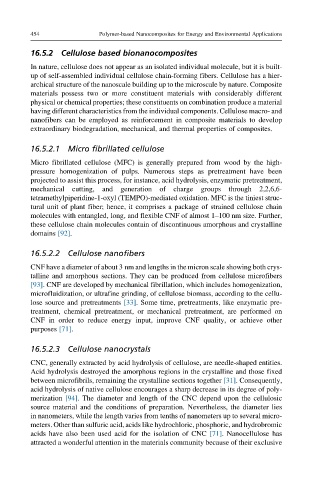Page 501 - Polymer-based Nanocomposites for Energy and Environmental Applications
P. 501
454 Polymer-based Nanocomposites for Energy and Environmental Applications
16.5.2 Cellulose based bionanocomposites
In nature, cellulose does not appear as an isolated individual molecule, but it is built-
up of self-assembled individual cellulose chain-forming fibers. Cellulose has a hier-
archical structure of the nanoscale building up to the microscale by nature. Composite
materials possess two or more constituent materials with considerably different
physical or chemical properties; these constituents on combination produce a material
having different characteristics from the individual components. Cellulose macro- and
nanofibers can be employed as reinforcement in composite materials to develop
extraordinary biodegradation, mechanical, and thermal properties of composites.
16.5.2.1 Micro fibrillated cellulose
Micro fibrillated cellulose (MFC) is generally prepared from wood by the high-
pressure homogenization of pulps. Numerous steps as pretreatment have been
projected to assist this process, for instance, acid hydrolysis, enzymatic pretreatment,
mechanical cutting, and generation of charge groups through 2,2,6,6-
tetramethylpiperidine-1-oxyl (TEMPO)-mediated oxidation. MFC is the tiniest struc-
tural unit of plant fiber; hence, it comprises a package of strained cellulose chain
molecules with entangled, long, and flexible CNF of almost 1–100 nm size. Further,
these cellulose chain molecules contain of discontinuous amorphous and crystalline
domains [92].
16.5.2.2 Cellulose nanofibers
CNF have a diameter of about 3 nm and lengths in the micron scale showing both crys-
talline and amorphous sections. They can be produced from cellulose microfibers
[93]. CNF are developed by mechanical fibrillation, which includes homogenization,
microfluidization, or ultrafine grinding, of cellulose biomass, according to the cellu-
lose source and pretreatments [33]. Some time, pretreatments, like enzymatic pre-
treatment, chemical pretreatment, or mechanical pretreatment, are performed on
CNF in order to reduce energy input, improve CNF quality, or achieve other
purposes [71].
16.5.2.3 Cellulose nanocrystals
CNC, generally extracted by acid hydrolysis of cellulose, are needle-shaped entities.
Acid hydrolysis destroyed the amorphous regions in the crystalline and those fixed
between microfibrils, remaining the crystalline sections together [31]. Consequently,
acid hydrolysis of native cellulose encourages a sharp decrease in its degree of poly-
merization [94]. The diameter and length of the CNC depend upon the cellulosic
source material and the conditions of preparation. Nevertheless, the diameter lies
in nanometers, while the length varies from tenths of nanometers up to several micro-
meters. Other than sulfuric acid, acids like hydrochloric, phosphoric, and hydrobromic
acids have also been used acid for the isolation of CNC [71]. Nanocellulose has
attracted a wonderful attention in the materials community because of their exclusive

